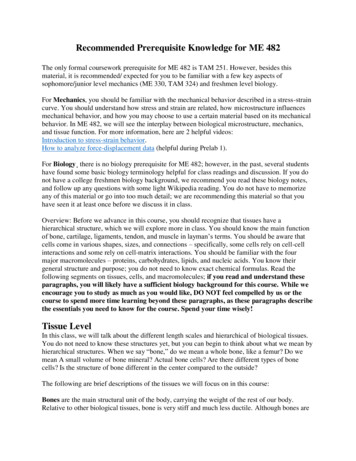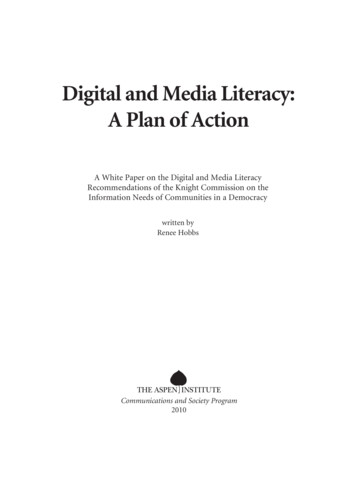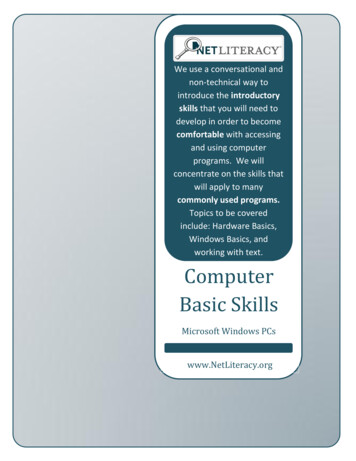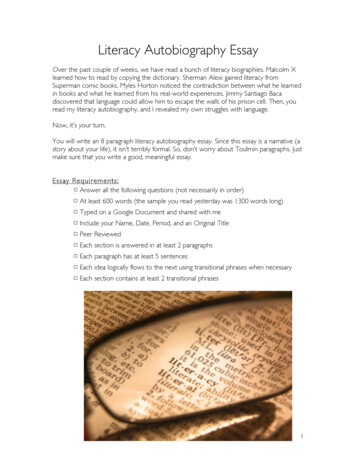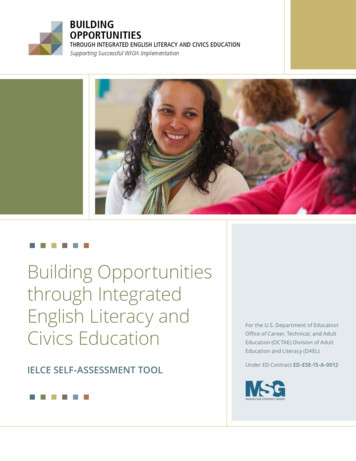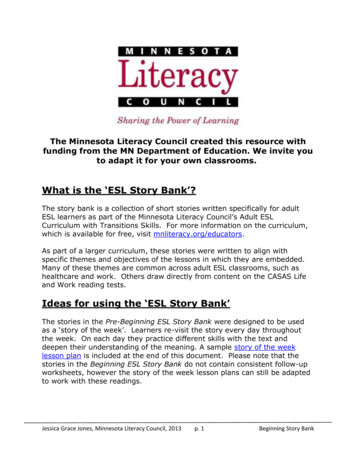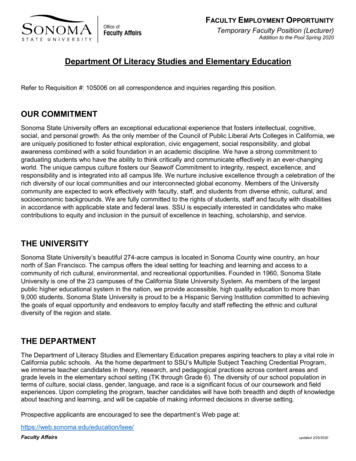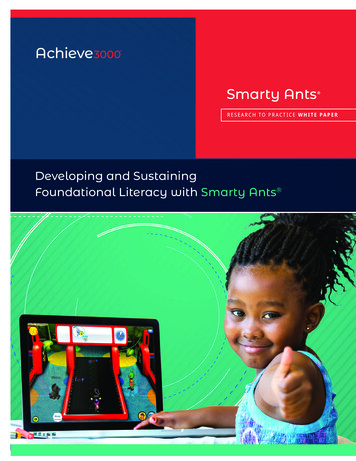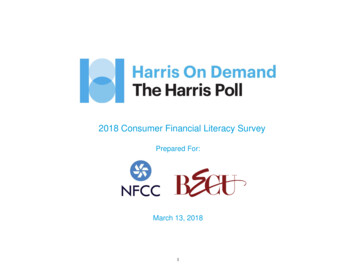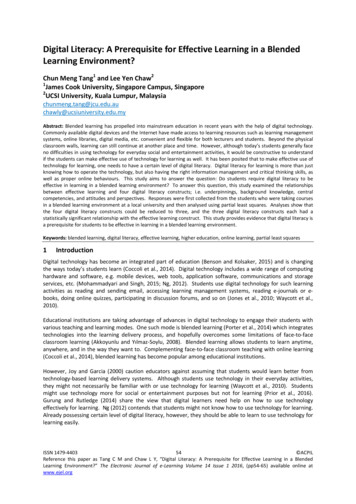
Transcription
Digital Literacy: A Prerequisite for Effective Learning in a BlendedLearning Environment?Chun Meng Tang1 and Lee Yen Chaw21James Cook University, Singapore Campus, Singapore2UCSI University, Kuala Lumpur, ity.edu.myAbstract: Blended learning has propelled into mainstream education in recent years with the help of digital technology.Commonly available digital devices and the Internet have made access to learning resources such as learning managementsystems, online libraries, digital media, etc. convenient and flexible for both lecturers and students. Beyond the physicalclassroom walls, learning can still continue at another place and time. However, although today’s students generally faceno difficulties in using technology for everyday social and entertainment activities, it would be constructive to understandif the students can make effective use of technology for learning as well. It has been posited that to make effective use oftechnology for learning, one needs to have a certain level of digital literacy. Digital literacy for learning is more than justknowing how to operate the technology, but also having the right information management and critical thinking skills, aswell as proper online behaviours. This study aims to answer the question: Do students require digital literacy to beeffective in learning in a blended learning environment? To answer this question, this study examined the relationshipsbetween effective learning and four digital literacy constructs; i.e. underpinnings, background knowledge, centralcompetencies, and attitudes and perspectives. Responses were first collected from the students who were taking coursesin a blended learning environment at a local university and then analysed using partial least squares. Analyses show thatthe four digital literacy constructs could be reduced to three, and the three digital literacy constructs each had astatistically significant relationship with the effective learning construct. This study provides evidence that digital literacy isa prerequisite for students to be effective in learning in a blended learning environment.Keywords: blended learning, digital literacy, effective learning, higher education, online learning, partial least squares1IntroductionDigital technology has become an integrated part of education (Benson and Kolsaker, 2015) and is changingthe ways today’s students learn (Coccoli et al., 2014). Digital technology includes a wide range of computinghardware and software, e.g. mobile devices, web tools, application software, communications and storageservices, etc. (Mohammadyari and Singh, 2015; Ng, 2012). Students use digital technology for such learningactivities as reading and sending email, accessing learning management systems, reading e‐journals or e‐books, doing online quizzes, participating in discussion forums, and so on (Jones et al., 2010; Waycott et al.,2010).Educational institutions are taking advantage of advances in digital technology to engage their students withvarious teaching and learning modes. One such mode is blended learning (Porter et al., 2014) which integratestechnologies into the learning delivery process, and hopefully overcomes some limitations of face‐to‐faceclassroom learning (Akkoyunlu and Yılmaz‐Soylu, 2008). Blended learning allows students to learn anytime,anywhere, and in the way they want to. Complementing face‐to‐face classroom teaching with online learning(Coccoli et al., 2014), blended learning has become popular among educational institutions.However, Joy and Garcia (2000) caution educators against assuming that students would learn better fromtechnology‐based learning delivery systems. Although students use technology in their everyday activities,they might not necessarily be familiar with or use technology for learning (Waycott et al., 2010). Studentsmight use technology more for social or entertainment purposes but not for learning (Prior et al., 2016).Gurung and Rutledge (2014) share the view that digital learners need help on how to use technologyeffectively for learning. Ng (2012) contends that students might not know how to use technology for learning.Already possessing certain level of digital literacy, however, they should be able to learn to use technology forlearning easily.ISSN 1479‐440354 ACPILReference this paper as Tang C M and Chaw L Y, “Digital Literacy: A Prerequisite for Effective Learning in a BlendedLearning Environment?” The Electronic Journal of e‐Learning Volume 14 Issue 1 2016, (pp54‐65) available online atwww.ejel.org
Chun Meng Tang and Lee Yen ChawPeople who have multiple literacies to use digital technology efficiently and effectively are deemed to bedigitally literate (Mohammadyari and Singh, 2015). As digital technology plays a key role in blended learning, itis expected that students need a certain level of digital literacy for them to learn effectively (Eshet, 2004).Hence, it is essential for educators to ask the question: Do students require digital literacy to be effective inlearning in a blended learning environment? This study aims to answer this question.The following sections provide an overview of blended learning, review the concept of digital literacy and itscomponents, explain the measurement of effective learning, describe the research design and method,present the data analyses and results, and conclude the paper.22.1Research backgroundBlended learningA learning delivery approach which blends face‐to‐face classroom learning and online learning, blendedlearning provides such flexibility as anytime and anywhere access to learning management systems (LMS). AnLMS provides an online delivery platform for lecturers and students to share learning resources, equippingthem with useful system tools and functions (Glogowska et al., 2011; De Smet et al., 2012). Blended learningpromotes independent learning and online cooperation, and yet retains some face‐to‐face classroom teaching(Deschacht and Goeman, 2015). The basic premise is to complement face‐to‐face classroom learning by givingstudents the learning flexibility as enabled by digital technology.Given limited classroom space and increasing student number, blended learning seems to be a feasiblesolution (Garrison and Vaugha, 2013) which meets the needs of students, educators, and universities (Moskal,Dziuban and Hartman, 2013). Blended learning brings some benefits, e.g. higher classroom efficiency, greaterteaching flexibility, more convenience for students, and better learning engagement (Owston, York andMurtha, 2013). Deschacht and Goeman (2015) analysed two groups of first‐year university students tounderstand if blended learning had an effect on their academic performance. Both groups took the samecourses and exams, but the course delivery mode was different. One group followed the blended learningapproach and the other, face‐to‐face classroom learning. The findings showed that blended learning improvedacademic performance.However, adopting blended learning does not necessarily improve the student learning experience (Cortizo etal., 2010). Benson and Kolsaker (2015) contend that technology is only one part of blended learning, and moreunderstanding is still needed about its pedagogical benefits. In addition, the digital environment that studentsare in today could have caused them to develop different learning attitudes and styles (Coccoli et al., 2014).Jones et al. (2010) collected data from some 500 first‐year students at five UK universities to study their use oftechnology for social and learning activities. Students born after 1983 were compared to those born before1983. The findings showed that there were differences in terms of the use of technology among the students,not just between the groups but within the groups as well. Margaryan, Littlejohn and Vojt (2011) surveyed160 third‐year university students to understand what digital technologies the students used and how theyused them. They compared students born in or after 1980 with those born before 1980. The findings showedthat those born in or after 1980 were not more advanced in their use of digital technologies nor did they havevery different learning styles from those born before 1980.Kember et al. (2010) find that blended learning is not just about using LMS as an online repository of learningmaterials. Instead, educators should incorporate learning activities that engage students to foster activelearning. Coccoli et al. (2014) explain that knowing technology alone is not enough for success in learning;equally important is that one needs to have the right competencies and attitudes. A study by Owston, Yorkand Murtha (2013), which analysed how student perceptions of blended learning could have affected theircourse grade, showed that compared to low‐achieving students, high‐achieving students were more satisfiedwith their blended learning courses, claiming that these courses were more convenient, more engaging, andthey learned better. Low‐achieving students might find blended learning courses challenging if they lackindependent study skills or if the difficulty level of the subject matter is high.www.ejel.org55ISSN 1479‐439X
The Electronic Journal of e‐Learning Volume 14 Issue 1 2016Blended learning can have different configurations of face‐to‐face classroom learning and online learning indifferent learning contexts (Garrison and Kanuka, 2004) and a good integration is always a challenge(McKenzie et al., 2013). Staker and Horn (2012) identifies four blended learning models for primary andsecondary education: Rotation, Flex, Self‐Blend, and Enriched‐Virtual. D2L (2014), a company that specialisesin developing integrated learning platforms, proposes five blended learning models: Face‐to‐Face Driver,Rotation, Flex, Online Lab, and Online Driver. Moskal, Dziuban and Hartman (2013) suggest that there is noone best blended learning model. Instead, there are a set of critical success factors, such as institutional goalsand objectives; alignment between goals of administrators and faculty members; organisational capacity;faculty development and course development support; support for online students and faculty; robust andreliable infrastructure; longitudinal data collection and assessment; policy development; and funding model.2.2Digital literacyToday’s students are familiar with digital technology and generally know how to access, create, and sharedigital information (Ting, 2015). Greene, Yu and Copeland (2014) suppose that to be digitally literate, one notonly needs to be able to search and manage, but also to scrutinise and integrate digital information. Althoughtoday’s students are generally considered tech‐savvy, many of them find it difficult to do so effectively. Theyconclude that students need to acquire planning, monitoring, and controlling skills in relation to informationmanagement, as well as critical thinking skills. Gilster (1997) supports the notion that to be digitally literate,one does not just know how to find information from the web, but also has the ability to understand andassemble information from different print or digital sources. Digital literacy involves the mastery of ideas, andis not just about using the technology itself.The European Framework for Digital Literacy (EFDL), an outcome of the DigEuLit project and initiated torecognise the importance of digital literacy, defines digital literacy as follows:Digital literacy is the awareness, attitude and ability of individuals to appropriately use digitaltools and facilities to identify, access, manage, integrate, evaluate, analyse and synthesize digitalresources, construct new knowledge, create media expressions, and communicate with others, inthe context of specific life situations, in order to enable constructive social action; and to reflectupon this process.” (Martin, 2006, p.155)Jisc (2014) emphasises that digital literacy is context‐dependent and suggests a seven‐element digital literacymodel: media literacy, information literacy, digital scholarship, learning skills, communications andcollaboration, career and identify management, and ICT literacy. Ng (2012) explains that digital literacycomprises three key dimensions: technical, cognitive, and social‐emotional. The technical dimension concernsthe skills needed to use IT proficiently. The cognitive dimension concerns the skills needed to search, evaluate,and synthesise digital information critically, and at the same time, to be conscious of any ethical, moral, andlegal issues. The social‐emotional dimension concerns the skills needed to socialise online in a proper manner.Bawden (2008) explains that the concept of digital literacy is very broad and can include very specific skills andcompetencies to general awareness and perspectives. He distinguishes four components of digital literacy: (1)underpinnings ‐ the ability to read and write as well as to use software packages and computers; (2)background knowledge ‐ an understanding of how digital and non‐digital information is created from variousforms of resources and communicated; (3) central competencies ‐ the ability to assemble knowledge frommultiple sources; and (4) attitudes and perspectives ‐ the ability to learn independently as well as to exhibitgood behaviour in a digital environment.Digital literacy needs to be renewed as digital technology evolves over time. It can be classified into threelevels (Martin, 2006): (1) digital competence ‐ digital know‐how; (2) digital usage ‐ applications of digitalcompetence; and (3) digital transformation ‐ creation of new knowledge as a result of digital usage. Prior et al.(2016) observe that students can exhibit different levels of digital literacy. Thus, assuming that all studentshave the same level or a certain level of digital literacy can lead to a problem in online learning – What thestudents are capable of doing might be different from the expectations of teachers.www.ejel.org56 ACPIL
digital information (Ting, 2015). Greene, Yu and Copeland (2014) suppose that to be digitally literate, one not only needs to be able to search and manage, but also to
